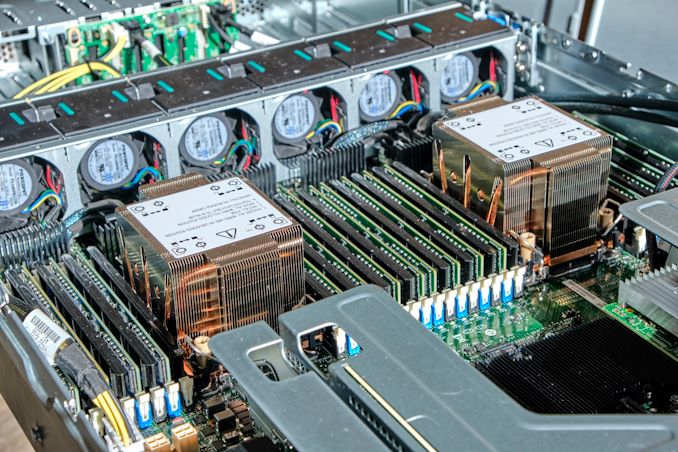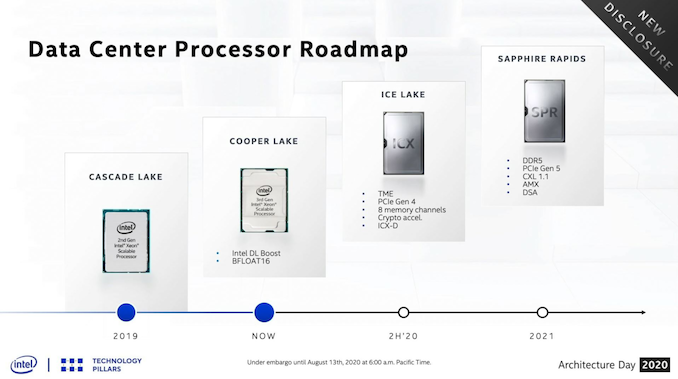Intel 3rd Gen Xeon Scalable (Ice Lake SP) Review: Generationally Big, Competitively Small
by Andrei Frumusanu on April 6, 2021 11:00 AM EST- Posted in
- Servers
- CPUs
- Intel
- Xeon
- Enterprise
- Xeon Scalable
- Ice Lake-SP
Conclusion & End Remarks
Today’s launch of the new 3rd gen Xeon Scalable processors is a major step forward for Intel and the company’s roadmap. Ice Lake SP had been baking in the oven for a very long time: originally planned for a 2020 release, Intel had only started production recently this January, so finally seeing the chips in silicon and in hand has been a relief.
Generationally Impressive
Technically, Ice Lake SP is an impressive and major generation leap for Intel’s enterprise line-up. Manufactured on a new 10nm process, node, employing a new core microarchitecture, faster memory with more memory channels, PCIe 4.0, new accelerator capabilities and VNNI instructions, security improvements – these are all just the tip of the iceberg that Ice Lake SP brings to the table.
In terms of generational performance uplifts, we saw some major progress today with the new Xeon 8380. With 40 cores at a higher TDP of 270W, the new flagship chip is a veritable beast with large increases in performance in almost all workloads. Major architectural improvements such as the new memory bandwidth optimisations are amongst what I found to be most impressive for the new parts, showcasing that Intel still has a few tricks up its sleeve in terms of design.
This being the first super-large 10nm chip design from Intel, the question of how efficiency would end up was a big question to the whole puzzle to the new generation line-up. On the Xeon 8380, a 40-core part at 270W, we saw a +18% increase in performance / W compared to the 28-core 205W Xeon 8280. This grew to a +36% perf/W advantage when limiting the ICX part to 205 as well. On the other hand, our mid-stack Xeon 6330 sample showed very little advantages to the Xeon 8280, even both are 28-core 205W designs. Due to the mix of good and bad results here, it seems we’ll have to delay a definitive verdict on the process node improvements to the future until we can get more SKUs, as the current variations are quite large.
Per-core performance, as well as single-thread performance of the new parts don’t quite achieve what I imagine Intel would have hoped through just the IPC gains of the design. The IPC gains are there and they’re notable, however the new parts also lose out on frequency, meaning the actual performance doesn’t move too much, although we did see smaller increases. Interestingly enough, this is roughly the same conclusion we came to when we tested Intel's Ice Lake notebook platform back in August 2019.
The Competitive Hurdle Still Stands
As impressive as the new Xeon 8380 is from a generational and technical stand-point, what really matters at the end of the day is how it fares up to the competition. I’ll be blunt here; nobody really expected the new ICL-SP parts to beat AMD or the new Arm competition – and it didn’t. The competitive gap had been so gigantic, with silly scenarios such as where competing 1-socket systems would outperform Intel’s 2-socket solutions. Ice Lake SP gets rid of those more embarrassing situations, and narrows the performance gap significantly, however the gap still remains, and is still undeniable.
We’ve only had access limited to the flagship Xeon 8380 and the mid-stack Xeon 6330 for the review today, however in a competitive landscape, both those chips lose out in both absolute performance as well as price/performance compared to AMD’s line-up.
Intel had been pushing very hard the software optimisation side of things, trying to differentiate themselves as well as novel technologies such as PMem (Optane DC persistent memory, essentially Optane memory modules), which unfortunately didn’t have enough time to cover for this piece. Indeed, we saw a larger focus on “whole system solutions” which take advantage of Intel’s broader product portfolio strengths in the enterprise market. The push for the new accelerator technologies means Intel needs to be working closely with partners and optimising public codebases to take advantage of these non-standard solutions, which might be a hurdle for deployments such as cloud services where interoperability might be important. While the theoretical gains can be large, anyone rolling a custom local software stack might see a limited benefit however, unless they are already experts with Intel's accelerator portfolio.
There’s also the looming Intel roadmap. While we are exulted to finally see Ice lake SP reach the market, Intel is promising the upcoming Sapphire Rapids chips for later this year, on a new platform with DDR5 and PCIe 5. Intel is set to have Ice Lake Xeon and Sapphire Rapids Xeon in the market concurrently, with the idea to manage both, especially for customers that apply the leading edge hardware as soon as it is available. It will be interesting to see the scale of the roll out of Ice Lake with this in mind.
At the end of the day, Ice Lake SP is a success. Performance is up, and performance per watt is up. I'm sure if we were able to test Intel's acceleration enhancements more thoroughly, we would be able to corroborate some of the results and hype that Intel wants to generate around its product. But even as a success, it’s not a traditional competitive success. The generational improvements are there and they are large, and as long as Intel is the market share leader, this should translate into upgraded systems and deployments throughout the enterprise industry. Intel is still in a tough competitive situation overall with the high quality the rest of the market is enabling.












169 Comments
View All Comments
mode_13h - Thursday, April 8, 2021 - link
Please tell me you did this test with an ICC released only a couple years ago, or else I feel embarrassed for you polluting this discussion with such irrelevant facts.Oxford Guy - Sunday, April 11, 2021 - link
It wasn't that long ago.If you want to increase the signal to noise ratio you should post something substantive.
For instance, if you think think ICC no longer produces faster Blender builds why not post some evidence to that effect?
eastcoast_pete - Tuesday, April 6, 2021 - link
This Xeon generation exists primarily because Intel had to come through and deliver something in 10 nm, after announcing the heck out of it for years. As an actual processor, they are not bad as far as Xeons are concerned, but clearly inferior to AMD's current EPYC line, especially on price/performance. Plus, we and the world know that the real update is around the corner within a year: Sapphire Rapids. That one promises a lot of performance uplift, not the least by having PCI-5 and at least the option of directly linked HBM for RAM. Lastly, if Intel would have managed to make this line compatible with the older socket (it's not), one could at least have used these Ice Lake Xeons to update Cooper Lake systems via a CPU swap. As it stands, I don't quite see the value proposition, unless you're in an Intel shop and need capacity very badly right now.Limadanilo2022 - Tuesday, April 6, 2021 - link
Agreed. Both Ice Lake and Rocket lake are just placeholders to try to make something before the real improvement comes with Saphire rapids and Alder Make respectively... I'm one that says that AMD really needs the competition right now to not get sloppy and become "2017-2020 Intel". I want to see both competing hard in the next years aheaddrothgery - Wednesday, April 7, 2021 - link
Rocket Lake is a stopgap. Ice Lake (and Ice Lake SP) were just late; they would have been unquestioned market leaders if launched on time and even now mostly just run into problems when the competition is throwing way more cores at the problem.AdrianBc - Wednesday, April 7, 2021 - link
No, Ice Lake Server cores have a much lower clock frequency and a much smaller L3 cache than Epyc 7xx3, so they are much slower core per core than AMD Milan for any general purpose application, e.g. software compilation.The Ice Lake Server cores have a double number of floating-point multipliers that can be used by AVX-512 programs, so they are faster (despite their clock frequency deficit) for the applications that are limited by FP multiplication throughput or that can use other special AVX-512 features, e.g. the instructions useful for machine learning.
Oxford Guy - Wednesday, April 7, 2021 - link
'limited by FP multiplication throughput or that can use other special AVX-512 features, e.g. the instructions useful for machine learning.'How do they compare with Power?
How do they compare with GPUs? (I realize that a GPU is very good at a much more limited palette of work types versus a general-purpose CPU. However... how much overlap there is between a GPU and AVX-512 is something at least non-experts will wonder about.)
AdrianBc - Thursday, April 8, 2021 - link
The best GPUs from NVIDIA and AMD can provide between 3 and 4 times more performance per watt than the best Intel Xeons with AVX-512.However most GPUs are usable only in applications where low precision is appropriate, i.e. graphics and machine learning.
The few GPUs that can be used for applications that need higher precision (e.g. NVIDIA A100 or Radeon Instinct) are extremely expensive, much more than Xeons or Epycs, and individuals or small businesses have very little chances to be able to buy them.
mode_13h - Friday, April 9, 2021 - link
Please re-check the price list. The top-end A100 does sell for a bit more than the $8K list price of the top Xeon and EPYC, however MI100 seems to be pretty close. perf/$ is still wildly in favor of GPUs.Unfortunately, if you're only looking at the GPUs' ordinary compute specs, you're missing their real point of differentiation, which is their low-precision tensor performance. That's far beyond what the CPUs can dream of!
Trust there are good reasons why Intel scrapped Xeon Phi, after flogging it for 2 generations (plus a few prior unreleased iterations), and adopted a pure GPU approach to compute!
mode_13h - Thursday, April 8, 2021 - link
"woulda, coulda, shoulda"Ice Lake SP is not even competitive with Rome. So, they missed their market window by quite a lot!